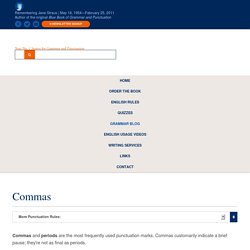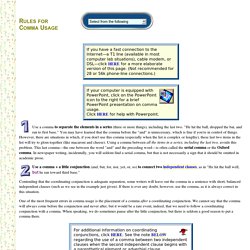

The Most Comma Mistakes. Draft is a series about the art and craft of writing.

As I noted in my earlier article, rules and conventions about when to use and not to use commas are legion. But certain errors keep popping up. Here are a few of them. Identification Crisis If I’ve seen it once, I’ve seen it a thousand times. I’m referring to a student’s writing a sentence like: I went to see the movie, “Midnight in Paris” with my friend, Jessie. Comma after “movie,” comma after “friend” and, sometimes, comma after “Paris” as well. I went to see the movie “Midnight in Paris” with my friend Jessie. If that seems wrong or weird or anything short of clearly right, bear with me a minute and take a look at another correct sentence: I went to see Woody Allen’s latest movie, “Midnight in Paris,” with my oldest friend, Jessie.
You need a comma after “movie” because this and only this is Mr. The syntactical situation I’m talking about is identifier-name. Grammatically, there are various ways of describing what’s going on. And even. Punctuation Rules. Commas and periods are the most frequently used punctuation marks.

Commas customarily indicate a brief pause; they're not as final as periods. Rule 1. Use commas to separate words and word groups in a simple series of three or more items. Example: My estate goes to my husband, son, daughter-in-law, and nephew. Note: When the last comma in a series comes before and or or (after daughter-in-law in the above example), it is known as the Oxford comma. Example: We had coffee, cheese and crackers and grapes. Adding a comma after crackers makes it clear that cheese and crackers represents one dish. We had coffee, cheese and crackers, and grapes. Fiction and nonfiction books generally prefer the Oxford comma. Rule 2. Example: He is a strong, healthy man. Example: We stayed at an expensive summer resort. Another way to determine if a comma is needed is to mentally put and between the two adjectives. Rule 3a. Incorrect: He walked all the way home, he shut the door. There are several simple remedies: Rules for Comma Usage. Use a comma to separate the elements in a series (three or more things), including the last two.

"He hit the ball, dropped the bat, and ran to first base. " You may have learned that the comma before the "and" is unnecessary, which is fine if you're in control of things. However, there are situations in which, if you don't use this comma (especially when the list is complex or lengthy), these last two items in the list will try to glom together (like macaroni and cheese). Using a comma between all the items in a series, including the last two, avoids this problem. This last comma—the one between the word "and" and the preceding word—is often called the serial comma or the Oxford comma. Use a comma + a little conjunction (and, but, for, nor, yet, or, so) to connect two independent clauses, as in "He hit the ball well, but he ran toward third base. " One of the most frequent errors in comma usage is the placement of a comma after a coordinating conjunction.
Use a comma to avoid confusion.